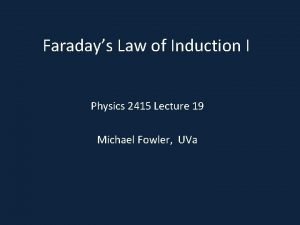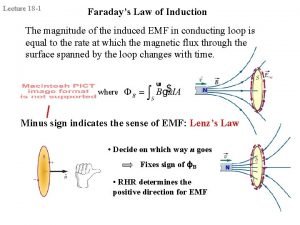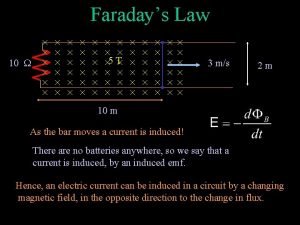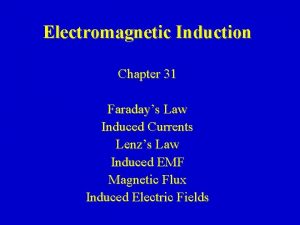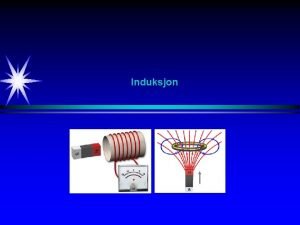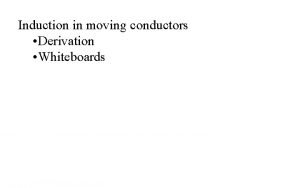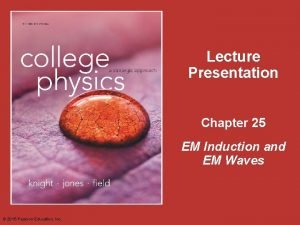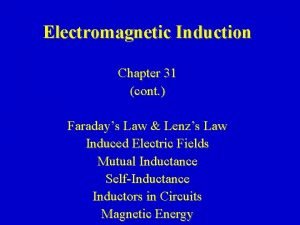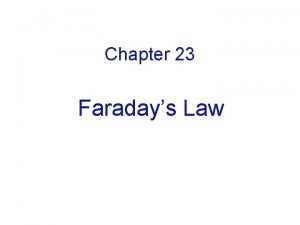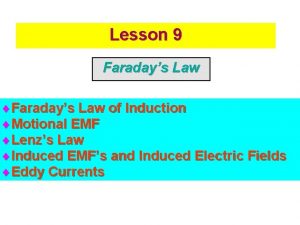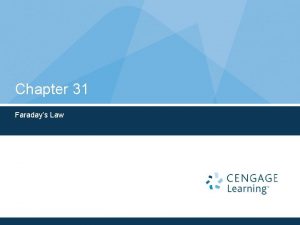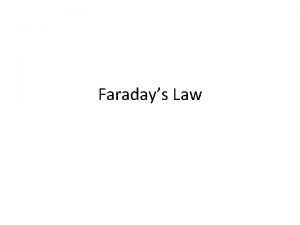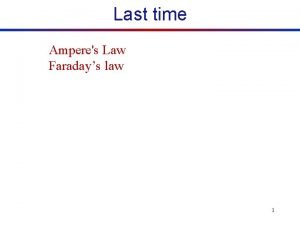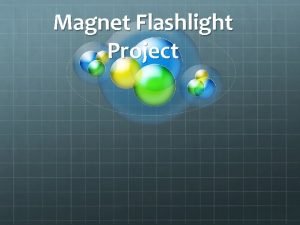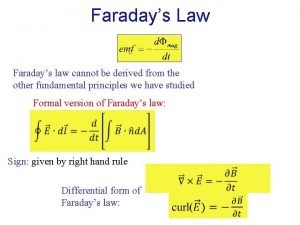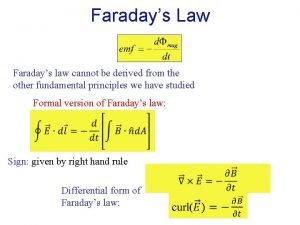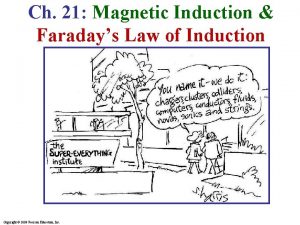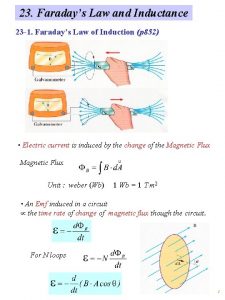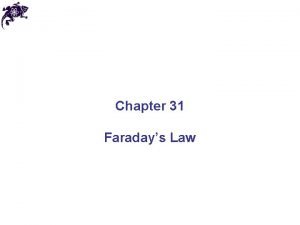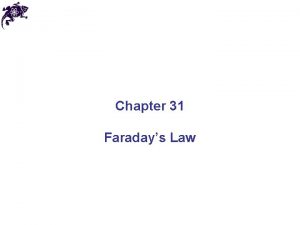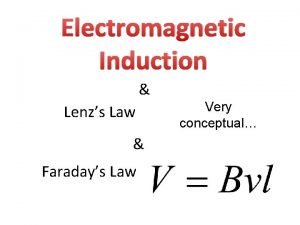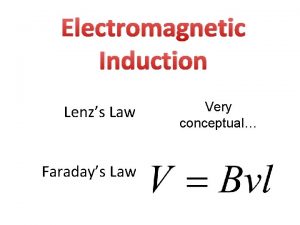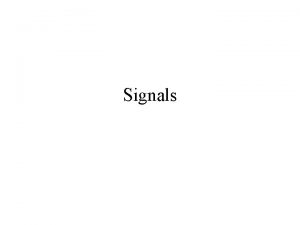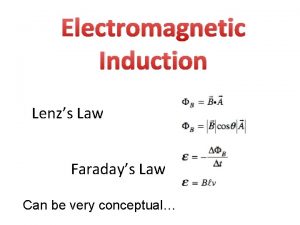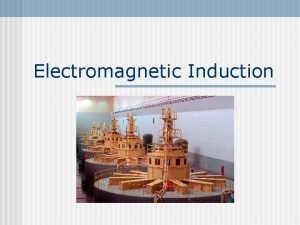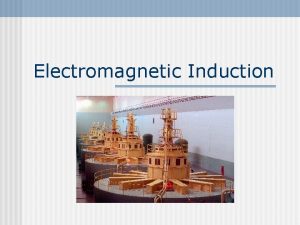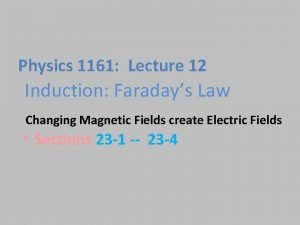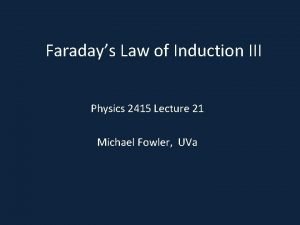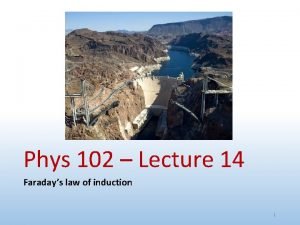Lecture 18 1 Faradays Law of Induction The
























- Slides: 24

Lecture 18 -1 Faraday’s Law of Induction The magnitude of the induced EMF in conducting loop is equal to the rate at which the magnetic flux through the surface spanned by the loop changes with time. N where Minus sign indicates the sense of EMF: Lenz’s Law • Decide on which way n goes Fixes sign of ϕB • RHR determines the positive direction for EMF N

Lecture 18 -2 Motional EMF of Sliding Conductor Induced EMF: Ø Lenz’s Law gives direction counter-clockwise ØFaraday’s Law Ø FM decelerates the bar Ø This EMF induces current I Ø Magnetic force FM acts on this I

Lecture 18 -3 Ways to Change Magnetic Flux • Changing the magnitude of the field within a conducting loop (or coil). • Changing the area of the loop (or coil) that lies within the magnetic field. • Changing the relative orientation of the field and the loop. motor generator http: //www. wvic. com/how-gen-works. htm

Lecture 18 -4 Other Examples of Induction + - Switch has been open for some time: Switch is just closed: Nothing happening EMF induced in Coil 2 + - Switch is just opened: EMF is induced again Switch is just closed: EMF is induced in coil - + Back emf (counter emf)

Lecture 18 -5 Eddy Currents A current induced in a solid conducting object, due to motion of the object in an external magnetic field. • The presence of eddy current in the object results in dissipation of electric energy that is derived from mechanical motion of the object. • The dissipation of electric energy in turn causes the loss of mechanical energy of the object, i. e. , the presence of the field damps motion of the object.

Lecture 18 -6 Reading Quiz 1 Which of the following statements is incorrect? A| The inductance of a coil with N turns is proportional to N 2 turns. B| The capacitance (C) an inductor (L) depends on geometric factors and the nature of the material inside C and L. C| The potential across an inductor depends only on the magnitude of the current through the inductor. D| The magnetic energy stored in an inductor is proportional to the square of the current through the inductor.

Lecture 18 -7 Self-Inductance • As current i through coil increases, magnetic flux through itself increases. This in turn induces counter EMF in the coil itself • When current i is decreasing, EMF is induced again in the coil itself in such a way as to slow the decrease. Self-induction (if flux linked) (henry) Faraday’s Law:

Lecture 18 -8 DEMO SELF INDUCTANCE 6 D-10

Lecture 18 -9 Inductance and Faraday’s Law (henry) + - compare with

Lecture 18 -10 Solenoid: Archetypical Inductor Current i flows through a long solenoid of radius r with N turns in length l For each turn For the solenoid or Inductance, like capacitance, only depends on geometry (if made of conductor and air)

Lecture 18 -11 Potential Difference Across Inductor +V ΔV internal resistance I • “Analogous” to a battery • An ideal inductor has r =0 V=0 • All dissipative effects are to be included in the internal resistance (i. e. , those of the iron core if any)

Lecture 18 -12 Warm-up quiz 2 The circuit is turned on at t=0. Which of the following statement is correct? R 1 V R 2 L A| At t = 0, the potential drop across the inductor is V; When t = ∞, the current through R 1 is V/R 1 B| At t = 0, the potential drop across the inductor is 0; When t = ∞, the current through R 1 is V/R 1. C| At t = 0, the potential drop across the inductor is V; When t = ∞, the current through R 1 is V/(R 1+R 2) D| At t = 0, the potential drop across the inductor is V; When t = ∞, the current through R 1 is V/R 2

Lecture 18 -13 1. 2. 3. Energy Stored By Inductor Switch on at t=0 As the current tries to begin flowing, self-inductance induces back EMF, thus opposing the increase of I. + Loop Rule: - Multiply through by I Rate at which energy is stored in inductor L Rate at which battery is supplying energy Rate at which energy is dissipated by the resistor

Lecture 18 -14 6 C 07 ENERGY STORED IN AN INDUCTOR

Lecture 18 -15 Where is the Energy Stored? • Energy must be stored in the magnetic field! Energy stored by a capacitor is stored in its electric field • Consider a long solenoid where area A • So energy density of the magnetic field is length l (Energy density of the electric field)

Lecture 18 -16 1. 2. 3. RL Circuits – Starting Current Switch to e at t=0 As the current tries to begin flowing, self-inductance induces back EMF, thus opposing the increase of I. Loop Rule: Solve this differential equation τ=L/R is the inductive time constant + -

Lecture 18 -17 GROWTH AND DECAY OF CURRENT OF AN RL CIRCUIT 6 C-05

Lecture 18 -18 Starting Current through Inductor vs Charging Capacitor

Lecture 18 -19 Remove Battery after Steady I already exists in RL Circuits 1. Initially steady current Io is flowing: 2. 3. Switch from e to f at t=0, causing back EMF to oppose the change. Loop Rule: 4. Solve this differential equation + I cannot instantly become zero! Self-induction like discharging a capacitor

Lecture 18 -20 Behavior of Inductors • Increasing Current – Initially, the inductor behaves like a battery connected in reverse. – After a long time, the inductor behaves like a conducting wire. • Decreasing Current – Initially, the inductor behaves like a reinforcement battery. – After a long time, the inductor behaves like a conducting wire.

Lecture 18 -21 Physics 241 October 27, 2011 10: 30 –Quiz 3 The switch in this circuit is initially open for a long time, and then closed at t = 0. What is the magnitude of the voltage across the inductor just after the switch is closed? a) zero b) V c) R / L d) V / R e) 2 V

Lecture 18 -22 Physics 241 October 27, 2011 11: 30 Quiz 3 The switch in this circuit is closed at t = 0. What is the magnitude of the voltage across the resistor a long time after the switch is closed? a) zero b) V c) R / L d) V / R e) 2 V

Lecture 18 -23 Physics 241 March 22, 2011 11: 30–Quiz 3 The switch in this circuit has been open for a long time. Then the switch is closed at t = 0. What is the magnitude of the current through the resistor immediately after the switch is closed? a) zero b) V / L c) R / L d) V / R e) 2 V / R

Lecture 18 -24 Warm up quizzes for Thursday Lecture Which of the following statement is true? A. B. C. D.
 What is induction in physics
What is induction in physics Faraday law
Faraday law Faradays law
Faradays law Chapter 31 faraday law ofinduction
Chapter 31 faraday law ofinduction Basic chemistry tutorial
Basic chemistry tutorial Magnetisk fluks
Magnetisk fluks 01:640:244 lecture notes - lecture 15: plat, idah, farad
01:640:244 lecture notes - lecture 15: plat, idah, farad Newton's first law and second law and third law
Newton's first law and second law and third law Si unit of newton's first law
Si unit of newton's first law Boyle's law charles law avogadro's law
Boyle's law charles law avogadro's law How to calculate boyle's law
How to calculate boyle's law Bvl physics
Bvl physics Faraday's law of electromagnetic induction ppt
Faraday's law of electromagnetic induction ppt Faraday's law of electromagnetic induction
Faraday's law of electromagnetic induction Hình ảnh bộ gõ cơ thể búng tay
Hình ảnh bộ gõ cơ thể búng tay Bổ thể
Bổ thể Tỉ lệ cơ thể trẻ em
Tỉ lệ cơ thể trẻ em Voi kéo gỗ như thế nào
Voi kéo gỗ như thế nào Chụp tư thế worms-breton
Chụp tư thế worms-breton Bài hát chúa yêu trần thế alleluia
Bài hát chúa yêu trần thế alleluia Các môn thể thao bắt đầu bằng tiếng chạy
Các môn thể thao bắt đầu bằng tiếng chạy Thế nào là hệ số cao nhất
Thế nào là hệ số cao nhất Các châu lục và đại dương trên thế giới
Các châu lục và đại dương trên thế giới Công thức tính thế năng
Công thức tính thế năng
